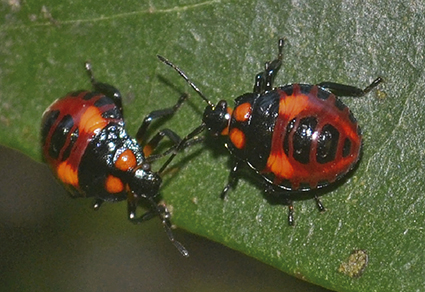Abstract
As predaceous insects, the Asopinae have a great economic importance. The knowledge about the development of the species is essential for use in biological control programs. However, only 1% of the Neotropical Asopinae species have the immature stages known. In this work we describe the egg and the five nymphal stages of Podisus graziae Brugnera, Roell & Lemaître, 2021 using light and scanning electron microscopy. The results show that P. graziae eggs and nymphs present unique characters which are not observed in other species of the genus and subfamily. As other Podisus species, the egg present long aero-mycropilar processes, however, the chorion and operculum have a ring of minute spine-like projections. As main diagnostic characters of nymphs, the iridescent coloration of head, thorax and abdominal plates, and a pair of yellow spots in the pronotum and anterior region of abdomen are noticed.
References
Bottega, C.H., Bianchi, F.M. & Campos, L.A. (2015) Ontogeny of the dorsal abdominal gland external scent efferent system in Pentatomidae (Hemiptera: Heteroptera). Annals of the Entomological Society of America, 108 (4), 1–10. https://doi.org/10.1093/aesa/sav052
Bundy, C.S. & McPherson, R.M. (2000) Morphological examination of stink bug (Heteroptera: Pentatomidae) eggs on cotton and soybeans, with a key to genera. Annals of the Entomological Society of America, 93 (3), 616–624.
Brugnera, R. & Grazia, J. (2018) External morphology of immature of Tynacantha marginata Dallas, 1851 (Hemiptera, Heteroptera, Pentatomidae). Zootaxa, 4378 (1), 121–128. https://doi.org/10.11646/zootaxa.4378.1.8
Brugnera, R., Campos, L.A. & Grazia, J. (2019) Morphology of Immature Stages, Chromatic Polymorphism of Adults and Natural History of Oplomus catena (Heteroptera: Pentatomidae: Asopinae). Neotropical entomology, 48 (6), 1046–1057.
Brugnera, R., Roell, T., Campos, L.A. & Grazia, J. (2020) Taxonomy of widespread Neotropical species of Podisus Herrich-Schäffer (Hemiptera: Pentatomidae: Asopinae): redescription of P. distinctus (Stål, 1860) and revalidation of P. fuscescens (Dallas, 1851). Zootaxa, 4751 (3), 546–562. https://doi.org/10.11646/zootaxa.4751.3.7
Brugnera, R., Limberger, G.M., Campos, L.A. & Grazia, J. (2022) The eggs and nymphs of predatory stink bugs (Hemiptera: Pentatomidae: Asopinae): what do we know? Zoology, 151, 125991. https://doi.org/10.1016/j.zool.2021.125991
Bundy, C.S. & McPherson, R.M. (2000) Morphological examination of stink bug (Heteroptera: Pentatomidae) eggs on cotton and soybeans, with a key to genera. Annals of the Entomological Society of America, 93 (3), 616–624. https://doi.org/10.1603/0013-8746(2000)093[0616:MEOSBH]2.0.CO;2
Javahery, M. (1994) Development of eggs in some true bugs (Hemiptera–Heteroptera). Part I. Pentatomoidea. The Canadian Entomologist, 126 (2), 401–433.
De Clercq, P. (2000) Predacious stinkbugs (Pentatomidae: Asopinae). In: Schaefer, C.W. & Panizzi, A.R. (Eds.), Heteroptera of Economic Importance. CRC Press, Boca Raton, Florida, pp. 737–789.
Matesco, V.C., Schwertner, C.F. & Grazia, J. (2008) Immature stages of Chinavia musiva (Berg, 1878): a unique pattern in the morphology of Chinavia Orian, 1965 (Hemiptera, Pentatomidae). Journal of Natural History, 42 (25–26), 1749–1763. https://doi.org/10.1080/00222930802124297
Matesco, V.C., Bianchi, F.M., Fürstenau, B.B.R.J., Da Silva, P.P., Campos, L.A. & Grazia, J. (2014) External egg structure of the Pentatomidae (Hemiptera: Heteroptera) and the search for characters with phylogenetic importance. Zootaxa, 3768 (3), 351–385. https://doi.org/10.11646/zootaxa.3768.3.5
Plata-Rueda, A., Martínez, L.C., Zanuncio, J.C. & Serrão, J.E. (2022) Advances zoophytophagous stinkbugs (Pentatomidae) use in agroecosystems: biology, feeding behavior and biological control. Journal of Pest Science, 95, 1485–1500. https://doi.org/10.1007/s10340-022-01518-z
Roca-Cusachs, M., Kim, J., Park, J. & Jung, S. (2020) Taxonomic review of the predatory stink bugs of the Korean Peninsula (Heteroptera: Pentatomidae: Asopinae), with a key to the Korean species and a discussion of their usefulness as biological control agents. Journal of Asia-Pacific Entomology, 23 (1), 113–123. https://doi.org/10.1016/j.aspen.2019.09.006
Roell, T., Genevcius, B. & Campos, L.A. (2020) Comparative morphology of clasping structures in predator stink bugs (Hemiptera: Pentatomidae: Asopinae): Insights into their function and evolution. Arthropod structure & development, 57, 100949. https://doi.org/10.1016/j.asd.2020.100949
Roell, T., Brugnera, R. & Lemaitre, V.A. (2021) Lost and found–Discovery of the presumed lost type of Arma pallipes Dallas, new synonymy and description of two new species of Podisus Herrich-Schäffer (Hemiptera: Pentatomidae: Asopinae). Zootaxa, 4958 (1), 570–584. https://doi.org/10.11646/zootaxa.4958.1.33
Schuh, R.T. & Weirauch, C. (2020) True bugs of the world (Hemiptera: Heteroptera): classification and natural history. Siri Scientific Press, Rochdale, 800 pp.
Thomas, D.B. (1992) Taxonomic synopsis of the asopine Pentatomidae (Heteroptera) of the Western Hemisphere Vol. 16. Thomas Say Foundation Monographs. Entomological Society of America, Lanham, Maryland, 156 pp.
Torres, J.B., Zanuncio, J.C. & Moura, M.A. (2006) The predatory stinkbug Podisus nigrispinus: biology, ecology and augmentative releases for lepidoperan larval control in Eucalyptus forests in Brazil. CABI Reviews, 18. [published online] https://doi.org/10.1079/PAVSNNR20061015
Vilímová, J. & Kutalová, K. (2012) Occurrence of certain cuticular structures confirms functionality of dorsal abdominal scent glands in Acanthosomatidae (Heteroptera: Pentatomoidea). Bulletin of Entomological Research, 102 (1), 29–42. https://doi.org/10.1017/S0007485311000344


